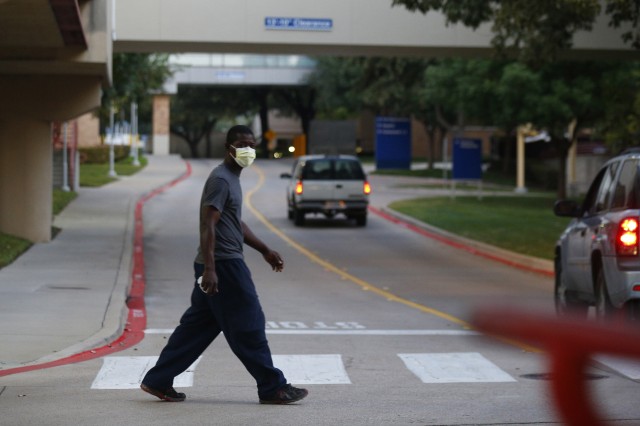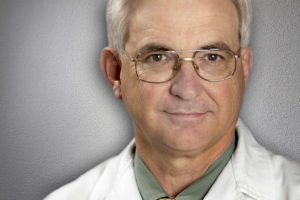Texas Ebola Expert: ‘There Was a Breakdown in Communication’

A pedestrian wears a surgical mask in front of Texas Health Presbyterian Hospital in Dallas, where Thomas Eric Duncan died this week of Ebola. AP Photo/The Dallas Morning News.
By Alisa Semiens
For Reporting Texas
Texas has been in the national headlines because of a Dallas hospital’s response to the nation’s first Ebola case. The patient, Thomas Duncan, died Wednesday. Gov. Rick Perry created a statewide task force earlier this week to figure out the best way to deal with future infectious disease outbreaks.
Reporting Texas’s Alisa Semiens spoke with Dr. Scott Lea, an infectious disease specialist at the University of Texas Medical Branch in Galveston. Lea is a clinical practitioner on Ebola exposure and therapy at the Galveston National Laboratory, part of UTMB and one of two national biocontainment laboratories. He shared his thoughts about Ebola and how hospitals should treat it.
Q. What do you think about the case in Dallas, where Mr. Duncan was sent home when he first went to the emergency room, only to return much sicker a few days later?
A. The gentleman came to the hospital and reported that he had been to Liberia. And then the information was not acted upon. There was a breakdown in communication, and it was just very unfortunate.
We call those “signal events.” And next time we know not to do that. Yes, we need to be concerned, but I don’t think they were negligent.
Q. What are the procedures for dealing with an Ebola patient?
A. If any patients come in suspected of having an infection, they are categorized in terms of what type of infection they have and how it might be transmitted. Then we know what kind of protective equipment we have to wear — gloves and gowns and masks and those types of things. In the case of Ebola, we would put the patient in strict isolation, which means a private room with a tile floor and walls that could be easily sterilized.
Everything that the patient used, like dishes, forks and spoons, would be disposable. We would be in gloves, gowns, masks and face shields to prevent the [patient’s] body fluids from getting on the body of the caregiver.
Q. Why is Ebola so deadly?
A. The virus gets into the body and attacks the inner lining of the blood vessels, where it causes what’s called a consumptive coagulopathy. That stops blood from clotting and, as it does, it is using up all the coagulation factors. As a result, patients are not able to quit bleeding.
What you see clinically is a person who is hemorrhaging from all the body parts — blood is coming from the nose, the eyes and the rectum.
This is a highly contagious, highly fatal disease. Over half the patients that are infected die. And so it’s a disease that gets people’s attention. Influenza is a highly contagious disease, but it doesn’t typically kill people. And so it is quite frightening when you encounter [a disease like Ebola] in nature.
This is a disease that is transmitted by blood and body fluids. You have to get blood and body fluid from the body of an infected individual into the body of an uninfected individual, and that doesn’t happen very frequently in a society [like] the United States. However, it does happen between parents and their children, where parents are frequently helping their children wash their hands and [help them use the toilet] and brush their teeth. It happens between man and wife, sexual partners, and it happens between health care workers and their patients. As health care workers, we are busy doing all kinds of examinations where we can be potentially exposed.
Q. Why has Ebola spread so rapidly in Africa?
A. We are not completely sure where the virus comes from in nature. We think it comes from bats, particularly fruit bats, in Africa.
The disease breaks out in epidemics, and they usually will burn themselves out within a few weeks. This particular epidemic has been rather large in West Africa, in Liberia and Sierra Leone. We think it has to do a lot to do with the very poor hospital and health care facilities that are available in those countries. Frequently, there’s only a building — no electricity, no water, no modern health care practices, and certainly no ability to sterilize equipment. Caregivers are usually family members, and it is not uncommon for them to be exposed to the body waste and vomit from patients.
Q. What is your message to Texans who are fearful of Ebola?
A. I don’t think the likelihood is high that anyone in the state of Texas is going to get this disease other than the caregivers, family, and doctors, health care workers and the people who have intimate contact and who are treating the disease. [Duncan spent several days with friends in a Dallas apartment before he was hospitalized. Health officials are monitoring people who came into contact with him, but no new cases have arisen.]
Q. What is the treatment for Ebola patients?
A. The way we get rid of viruses is vaccines. Look at measles, mumps and chicken pox, things like influenza — those are all viral diseases that we immunize people for. Unfortunately there is not an Ebola vaccine, and vaccines don’t help once the patient is sick. There are two other avenues that you can use to treat patients. One is to use so-called antibodies, where we give the patient a monoclonal antibody that is designed specifically for the Ebola virus. The drug that you have seen in the news lately is called ZMapp, a biologically engineered antibody that’s produced in a plant. Unfortunately, there are only very, very small amounts of that drug at the present time, and it’s not something that is easy to produce.
The other avenue is some type of antiviral agent, essentially an antibiotic for the virus. There aren’t too many of those drugs around, but in this case it turns out they have something called short interfering RNA, a little piece of genetic material that is designed to interfere with the replication of the viral genetic material, and it seems to be effective in Ebola. It’s not been tested in large studies, but it is something that seems to work in animal models.
